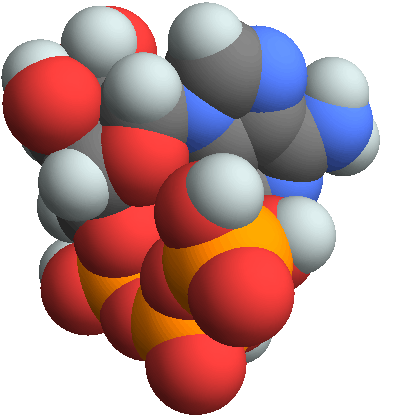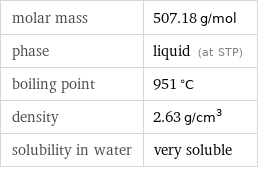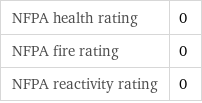Input interpretation

adenosine triphosphate
Chemical names and formulas
![formula | C_10H_16N_5O_13P_3 name | adenosine triphosphate IUPAC name | [[(2R, 3S, 4R, 5R)-5-(6-aminopurin-9-yl)-3, 4-dihydroxyoxolan-2-yl]methoxy-hydroxyphosphoryl] phosphono hydrogen phosphate alternate names | adenosine 5'-(tetrahydrogen triphosphate) mass fractions | C (carbon) 23.7% | H (hydrogen) 3.18% | N (nitrogen) 13.8% | O (oxygen) 41% | P (phosphorus) 18.3%](../image_source/a3c35699efd5edc4092e476a01be3c11.png)
formula | C_10H_16N_5O_13P_3 name | adenosine triphosphate IUPAC name | [[(2R, 3S, 4R, 5R)-5-(6-aminopurin-9-yl)-3, 4-dihydroxyoxolan-2-yl]methoxy-hydroxyphosphoryl] phosphono hydrogen phosphate alternate names | adenosine 5'-(tetrahydrogen triphosphate) mass fractions | C (carbon) 23.7% | H (hydrogen) 3.18% | N (nitrogen) 13.8% | O (oxygen) 41% | P (phosphorus) 18.3%
Lewis structure

Draw the Lewis structure of adenosine triphosphate. Start by drawing the overall structure of the molecule, ignoring potential double and triple bonds: Count the total valence electrons of the carbon (n_C, val = 4), hydrogen (n_H, val = 1), nitrogen (n_N, val = 5), oxygen (n_O, val = 6), and phosphorus (n_P, val = 5) atoms: 10 n_C, val + 16 n_H, val + 5 n_N, val + 13 n_O, val + 3 n_P, val = 174 Calculate the number of electrons needed to completely fill the valence shells for carbon (n_C, full = 8), hydrogen (n_H, full = 2), nitrogen (n_N, full = 8), oxygen (n_O, full = 8), and phosphorus (n_P, full = 8): 10 n_C, full + 16 n_H, full + 5 n_N, full + 13 n_O, full + 3 n_P, full = 280 Subtracting these two numbers shows that 280 - 174 = 106 bonding electrons are needed. Each bond has two electrons, so in addition to the 49 bonds already present in the diagram we expect to add 4 bonds. To minimize formal charge oxygen wants 2 bonds, nitrogen wants 3 bonds, and carbon wants 4 bonds. Identify the atoms that want additional bonds and the number of electrons remaining on each atom: Add 4 bonds by pairing electrons between adjacent highlighted atoms. Additionally, atoms with large electronegativities can minimize their formal charge by forcing atoms with smaller electronegativities on period 3 or higher to expand their valence shells. The electronegativities of the atoms are 2.19 (phosphorus), 2.20 (hydrogen), 2.55 (carbon), 3.04 (nitrogen), and 3.44 (oxygen). Because the electronegativity of phosphorus is smaller than the electronegativity of oxygen, expand the valence shell of phosphorus to 5 bonds in 3 places. Therefore we add a total of 7 bonds to the diagram. Note that the six atom ring is aromatic, so that the single and double bonds may be rearranged: Answer: | |
3D structure

3D structure
Basic properties

molar mass | 507.18 g/mol phase | liquid (at STP) boiling point | 951 °C density | 2.63 g/cm^3 solubility in water | very soluble
Units

Hydrophobicity and permeability properties

experimental LogP hydrophobicity | -5.5 predicted LogP hydrophobicity | -0.83 predicted LogS | -2.05
Basic drug properties

approval status | approved | nutraceutical | small molecule drug categories | dietary supplement | micronutrient

brand names | adephos | adetol | adynol | atipi | atriphos | cardenosine | fosfobion | glucobasin | myotriphos | phosphobion | striadyne | triadenyl | triphosphaden
Liquid properties (at STP)

density | 2.63 g/cm^3
Units

Thermodynamic properties

molar heat of vaporization | 145.1 kJ/mol specific heat of vaporization | 0.2861 kJ/g (at STP)
Chemical identifiers

CAS number | 56-65-5 Beilstein number | 73010 PubChem CID number | 5957 PubChem SID number | 3304 SMILES identifier | C1=NC2=C(C(=N1)N)N=CN2C3C(C(C(O3)COP(=O)(O)OP(=O)(O)OP(=O)(O)O)O)O InChI identifier | InChI=1/C10H16N5O13P3/c11-8-5-9(13-2-12-8)15(3-14-5)10-7(17)6(16)4(26-10)1-25-30(21, 22)28-31(23, 24)27-29(18, 19)20/h2-4, 6-7, 10, 16-17H, 1H2, (H, 21, 22)(H, 23, 24)(H2, 11, 12, 13)(H2, 18, 19, 20)/f/h18-19, 21, 23H, 11H2 InChI key | ZKHQWZAMYRWXGA-FJYXAIENDD EU number | 200-283-2 RTECS number | AU7416000 NSC number | 20268
NFPA label

NFPA label

NFPA health rating | 0 NFPA fire rating | 0 NFPA reactivity rating | 0
Safety properties

flash point | 529 °C